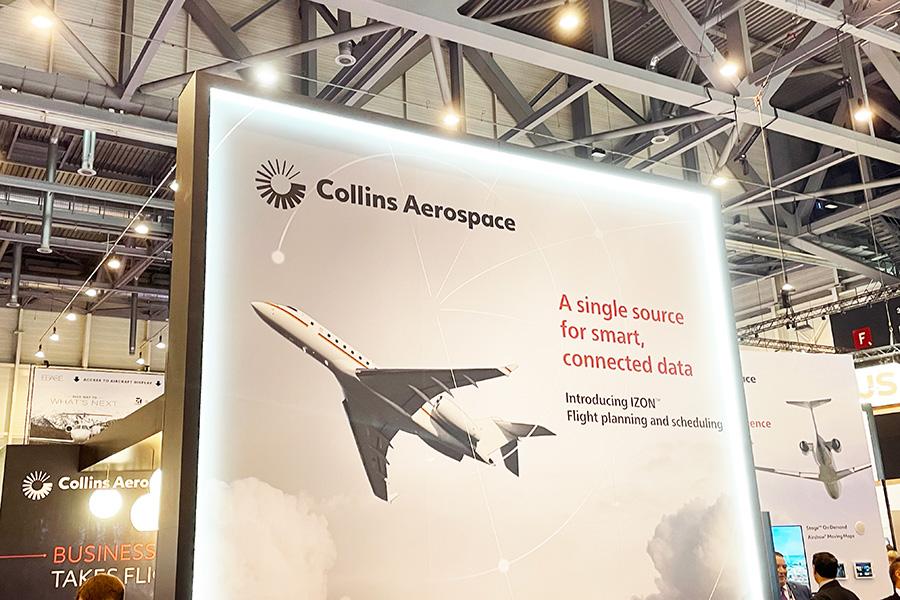
GENEVA—"We have this fundamental belief that we're at a tipping point when it comes to digital solutions for aerospace," says Erin McCleave, the strategy vice-president of Collins Aerospace's newly minted Connected Aviation Solutions division. "We've all been talking about it for years, we've all believed it was coming. The data is there. I think any open questions of five years ago about the value propositions and whether we could truly convert data to value have been put to bed, and now it's just: how can we run fast and bring those solutions?"
If the very existence of the division McCleave works for was not proof in itself of Collins' belief in the power of data to transform the business' future, an acquisition it completed around the same time Connected Aviation Solutions was stood up ought to provide the clincher.
FlightAware is very well known as a consumer brand, the company's accumulated data sets of aircraft in flight made available through apps and online. But despite its public-facing visibility, the majority of the company's work involves supplying a plethora of raw and analyzed data to businesses. Collins was a FlightAware customer before moving to buy the data firm last year.
"It completes the circle for Collins," says Paul Brough, a FlightAware director of key account management who, like McCleave, spoke with ShowNews at the company's stand within the Palexpo convention center. "Now they have access to data they didn't have before. There's a tremendous amount of the Collins portfolio that would benefit from ingesting FlightAware data and giving more value-add to their market of avionics."
The first, and most obvious, fruits of the merger is the launch of Izon, Collins' connected platform, which takes data from multiple sources—including FlightAware's aggregated and analyzed data sets—and brings it to users such as pilots, schedulers, flight departments and maintenance managers in a way that helps answer their questions and assist in achieving their objectives.
To the outsider, it is FlightAware's consumer product that makes it a surprising acquisition for an aerospace conglomerate; but, as McCleave and her new FlightAware colleagues explain, the fact that FlightAware is a digital business could prove to be the element that Collins will find most transformative.
"Those of us who grew up in aerospace—I’ve been in aerospace for 25 years—we know there's a certain pace in aerospace development cycles," McCleave says. "That doesn't work in the digital world. We set up this [division] as a business that can run like a digital business within an aerospace company. That, plus the FlightAware capabilities and content, just unlocks completely new propositions for us."
FlightAware's data sets are not limited to the parameters most users of their flight-tracking offering will be aware of. The company believes its fusion of ADS-B, satellite and ground-based data—such as those supplied by air navigation service providers—already results in more accurate ETAs than rival flight-tracking platforms. Other information, such as pushback times, are also available from them, and could potentially be enhanced as a result of the merger.
As part of Collins, FlightAware can access even more granular information: Brough notes that Collins produces door sensors for aircraft, and can access data showing when cabin doors are closed on airliners; this will provide a more accurate time for pushback than FlightAware's current information source, which is a sensor showing when the wheel has rotated 180 deg.
The company has recently begun providing a product called TODE (Taxi Out Duration Estimate) which will generate far more accurate predictions of time between pushback and takeoff by interrogating multiple live data feeds and running them through a machine-learning algorithm.
"Three hours before the scheduled departure, it's going to start looking at that aircraft's planned pushback time," says Toby Tucker, FlightAware's sales director for the EMEA region. "It's going to look at all the traffic from those schedules due to be starting up as well, have a look at the current number of aircraft with transponders turned on, look in the queues, the conga lines for the runway. Taking all that together, it's going to say your taxi-out duration is going to be this, versus what you think it's going to be."
Currently, all taxi times in the U.S. are estimated at a notional and uniform 10 minutes. Brough points out the fuel savings and schedule improvements that can be derived when airlines and pilots have a better and more reliable idea of how long they will spend on the ground after pushback.
The speed with which FlightAware can develop new products like TODE is one thing Collins was keen to leverage and which led to them proceeding with the acquisition, McCleave says. Another is perhaps less easy to put a value figure on, but could prove to be the most important part of the deal.
"The consumer version of FlightAware that we all know and love and use to track our flights, that's not going anywhere," she says. "We believe it's the best. We have a lot of data to back that up, but I think people believe it because they see it and they've been using it for years. You, me, buyers for corporate flight departments, airline executives, all use it too. People interface with it on a much more regular and personal level. And these are the same people who are making decisions about what dataset should back up the digital solutions."





